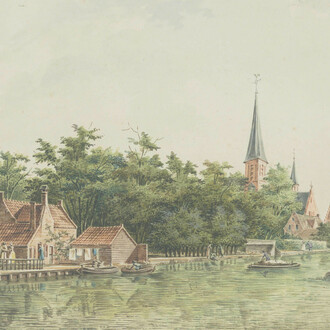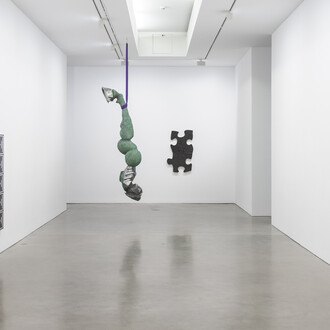carlier | gebauer is pleased to present a solo exhibition with Asta Gröting opening Friday, 26th April from 6-9pm. Not feeling too cheerful: reclining figures, facades and more will be the artist’s fifth solo exhibition with the gallery.
In Asta Gröting’s manifold artistic practices, which she has developed since the mid-1980s, the artist translates sculptural thought in diverse media. Gröting inverts the lexicon of monumental sculpture to draw our attention to absence and the physical and emotional rifts between people and things. Whether addressing family members, friends, lovers, or historical figures, Gröting’s work across media seeks to cast abstract qualities such as thought, intimacy, mourning, conflict, and subjectivity. Her ongoing engagement with gaps, interior spaces, and inner organs questions the social body by taking something away from it and, in the words of writer Deborah Levy, “allows this absence to do the talking.” Gröting’s current exhibition with carlier | gebauer addresses questions of vulnerability, injury, and repression through three new work cycles, as well as selected earlier works. The works in the exhibition evince an expanded understanding of the body, which brings to mind Michel Serres’ notion of the “mingled body.” According to Serres, the body is “a world” an open, mixed entity that comes into being through contact with other bodies, whether human bodies, social bodies, or metaphorical bodies. In Gröting’s works, we see a fascination with the invisible worlds that lie beneath a surface or in the quiet abyss that might reside between two bodies or things.
To create her recent series Berlin Fassaden (2016–2018), Gröting cast the facades of public buildings damaged by the Second World War in silicone. Like faces, buildings also have pimples, scars, and injuries. Gröting’s casts not only reveal impressions of the facades’ architectural structure, but also pull the depth of its bullet holes out onto its surface— forming bulbous protuberances that also include bits of sandstone particles, dirt, and dust that have collected in the holes over the decades. As such structures are rapidly being renovated as part of urban renewal—as well as post-war Germany’s ongoing attempt to rid its urban surfaces from remnants of the war—Gröting’s forensic approach to Berlin’s damaged facades can be understood in this context as a protest against forgetting. The Fassaden act as a sculptural slow-exposures, “pushing through the 20th century into the 21st in one simultaneous moment.” Gröting’s latest video, Things, exhibits a similar emphasis on slowness. Sixteen sundry items ranging from the mundane (a glove) to the absurd (an octopus) sail into the sky and slowly float downwards. Gesturing towards the immense range of goods that surround us on a daily basis, this slow motion homage to objects examines each item with a languid intensity that borders on the comedic.
With Reclining Figures, Gröting subverts traditional art historical associations related with this posture: rather than opening a figure up to view, she conceals it—an operation that nonetheless reveals the existential exposure of a human body lying prone on the ground. The Reclining Figures comprise wax- and epoxy-resin cast sleeping bags, twisted into variable contortions. Their tangled and cocoon-like appearance gestures towards the fragility of the human form and the fleeting, impermanent nature of attempts to protect it. Emancipated from the confines of the body, the sculpture Verdauungswege (1990) not only exposes a part of the body’s unfamiliar interior, but also gestures towards the more sensual and affective aspects of the enteric nervous system—splayed on the floor in front of us is the body’s “second brain,” which ancient philosophers claimed was the home of the soul. Tinted and mirrored glass emoji sculptures, entitled Not feeling too cheerful, impassively survey the exhibition from their perch on the wall—their emotional responses smoothed over into the cool gloss of a pictogram.
Asta Gröting (b. 1961, Herford) lives and works in Berlin. Upcoming exhibitions include the solo exhibition Where do you see yourself in 20 years at Centre Pasquart in Biel/Bienne, as well as the group exhibitions Life Casts, James-Simon-Galerie, Staatliche Museen zu Berlin; Kleinplastik Triennale, Fellbach; L’homme qui marche, Kunsthalle Bielefeld; Sculptures infinies, Palais des Beaux Arts, Paris; and Goethe – Verwandlung der Welt, Bundeskunsthalle, Bonn. She has had solo exhibitions at KINDL – Centre for Contemporary Art, Berlin; Kunstraum Dornbirn, Austria; ZKM Zentrum für Kunst und Medientechnologien, Karlsruhe; n.b.k., Berlin; Lentos Kunstmuseum Linz; Henry Moore Institute, Leeds; and Marta Herford. She has participated in numerous large-scale international exhibitions, including 22nd São Paulo Biennial, the 8th and 14th Biennale of Sydney, and the 44th Venice Biennale. Gröting is a professor at the Hochschule für Bildende Künste Braunschweig.
















